We're into the final straight before Destiny 2: Lightfall launches and Bungie is firing off new information at a frankly bewildering rate. Today, it's the turn of Strand, which is the new damage type being added. As such, it comes with three new subclasses, which the developer has broken down in detail on its site along with the trailer embedded above.
I was given a preview of this stuff last week and the chance to talk with design lead Kevin Yanes and feature lead Eric Smith and put questions about Strand and ability design to them. It was a wide-ranging discussion taking in everything from what the actual power fantasy of Strand is, through how to buff roaming supers, and most incredibly why we will not be transforming into giant egg-spewing spiders anytime soon. Here are the highlights.
Strand will be easier to unlock than Stasis
Right off the rip, let's deal with one of the biggest worries when it comes to Strand: How long the subclass will take to unlock across all three characters. Acquiring all the Aspects and Fragments for Stasis in Beyond Light was notoriously grindy, but Bungie promises that won't be the case with Strand. "We learned a lot from the Born in Darkness quest," says Yanes. "The friction there was way too high, especially for newer players who were coming in and just wanted to see the new stuff." Unlocking Strand will still require players to complete the Lightfall campaign, but Bungie seems to have heard the complaints and wants to make the process much more user-friendly. "At campaign completion you're actually going to have a fairly representative subclass, unlike Stasis, which was just a skeleton of a subclass."
You can also expect more Aspects and Fragments to be released as part of the seasonal model over the course of 2023. "By the end of the year you're going to have a complete subclass kit that will be able to stand toe-to-toe with your existing suite of powers, and speak to a play style you currently don't have," says Yanes. My takeaway is that although it does sound like you'll need to play the campaign on each character to unlock Strand, you're going to have more freedom to choose what you unlock and it should feel less laborious. Certainly I don't expect to be doing the equivalent of schlepping around the map shooting crystals with Salvation's Grip this time around.
Strand is the high-APM class
I have to confess that, before the interview, I still didn't totally get the power fantasy of Strand, beyond the obvious appeal to Spider-Man enjoyers. Where it clicks for me is when Smith and Yanes start talking about how Strand is the high-APM—or actions per minute—class. Bungie wanted Strand to play completely differently to the Light subclasses and Stasis, which already offered a bunch of different ways to melt monsters and control crowds of mobs respectively. They needed to find a different role for Strand. "We almost stumbled into the APM idea," says Yanes. "We found it, embraced it, and kept going. The key there is it's really easy to get in and start messing around with Strand, and have fun, but it has the depth to reward people who explore. Things like grabbing a Tangle and throwing it and then grappling to the same Tangle and following up with a grapple punch. That's something you cannot do with any of the other subclasses. But when you string those actions together you feel like a god."
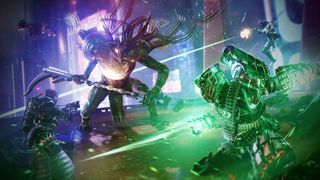
Tangles are the Warmind Cell replacement
Okay, let's talk about Tangles. Whenever an enemy that's affected by any sort of Strand debuff dies, it will unravel into a swirling, volatile bundle of Strand that's called a Tangle. You can pick a Tangle up and throw it as a bomb or shoot it where it lies. You can also grapple to a Tangle without spending your ability charge. As you'd expect from Destiny, various subclass Aspects and pieces of exotic gear will generate or interact with Tangles. For example, the Quicksilver Storm exotic auto rifle creates Tangles from kills in Grenade Launcher mode, provided you have its exotic catalyst. Smith thinks Tangles are key to the high APM experience: "You'll see these things pop up and use your instinct to alter the way you approach the encounter. We wanted to [give Strand] this high-APM skill ceiling, where if I can chain all these things together in a dynamic way I'm going to really maximise my effectiveness."
As players have already speculated, Tangles are effectively the replacement for Warmind Cells, which are being deprecated as part of a huge revamp coming to the mod system with Lightfall. "Tangles came from our desire to take Warmind Cells, grab part of that loop, and bring it into the core [gameplay]," confirms Yanes. "We knew [Warmind Cells] were going to go away. They were never really intended to live forever. And so the question became: 'What's a class-based version of Warmind Cells that's cohesive, married to a damage type, and has a new set of interactions and verbs behind it?'"
The biggest gaming news, reviews and hardware deals
Keep up to date with the most important stories and the best deals, as picked by the PC Gamer team.
Strand is the first subclass to grant three melee charges
I remember triple melee charges being leaked back in August last year, before we even knew the next subclass was Strand. "Historically, we tend not to give players three melee charges by default," says Smith, "but with the [Strand] Titan and Warlock we give them three. The Titan's melee sends you forward a considerable distance, so you're able to close a gap pretty easily by chaining three melees together. The speed at which you can move because of that is really high." Mobility and aerial play will be core to all the Strand subclasses, but Hunters will be the ones permanently up in the rafters.
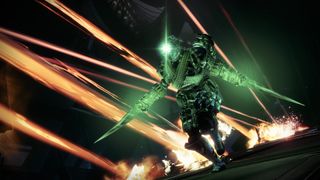
Bungie expects Hunters to create their own 'grapple arenas'
Theoretically, Hunters have always been the high agility class, so it's no surprise that Threadrunner goes hardest with the grapple ability. "Hunter has this Aspect called Widow's Silk that creates a grapple Tangle at the point of impact," explains Smith. "Not only does Widow's Silk create these grapple Tangles, but it also gives me two grapple charges. So I can grapple once to create this point, and then if I grapple to that point again using my second charge—or my teammate grapples to it—it won't cost any grapple energy. If we create a chain of grapple Tangles, we can all grapple for free and cover a huge distance."
A carefully set up team can do some nonsensical things and end your frustration with jumping puzzles.
—Kevin Yanes, design lead
Grapple Tangles also negate the five-second lockout that otherwise prevents Hunters from using both charges back-to-back. As for why there's a lockout at all, Yanes explains the team's philosophy regarding movement abilities: "We really like expressive movement. Icarus Dash, Shiver Strike, Cryoclasm, Thruster… But one of the things we pay a lot of attention to is what the uptime of that movement looks like. Grapple is super expressive, and we absolutely want you to have the ability to displace yourself, but you've got to make sure you're managing your [ability energy] economy."
He says that by chaining grapple Tangles his team has been able to get halfway across the King's Fall ships section. "A carefully set up team can probably do some nonsensical things and end your frustration with some of the jumping puzzles." Bungie doesn't want to go back and re-author old locations to add explicit grapple opportunities, though, because they want players to feel like they're almost cheating with their mastery of Strand.
Both developers expect to see a ton of emergent gameplay as players experiment with the Strand kit, and especially the grapple. "For us, that sort of functionality is a little bit scary to put into a game like Destiny, but that's where we want to be," says Smith. "We want to be slightly scared of the things we're making, because otherwise we're not pushing the envelope." Yanes agrees, and gives an example of how he saved a falling teammate by throwing out a Tangle for them to grapple to: "Novel interactions are the depth I'm talking about, where people start to experiment with the sandbox we've made and discover new use cases. Some that we guarantee are not intended. That's a successful sandbox right there. Here are the tools, here are the rules, godspeed and good luck."
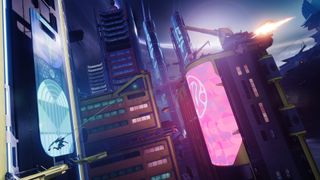
Grapple isn't just about mobility, it's a powerful offensive tool
We wanted the grapple to be able to read the player's mind.
—Eric Smith, feature lead
Getting the tuning of the grapple ability right sounds like one of the hardest parts of developing Strand. "We wanted the grapple to be able to read the player's mind a bit," says Smith. "We also wanted it to be usable by all classes, which means it had to take up your grenade slot, which means it had to be as powerful as other grenades in a combat situation. To remedy that we added the grapple punch, where you press the melee button while grappling and you do this powered-up third-person punch that does AoE damage and debuffs enemies."
Hunters also have a particularly cool ability when using their Ensnaring Slam aspect that sees them do a gainer backflip before diving to the ground suspending any nearby dudes. Again, it's easy to envision how cool that's going to be when strung together with grapples.
Critical to understanding how grappling works in Destiny 2 is that you don't need to attach your rope to a surface. "It's very versatile, very easy to use," says Smith. "When I decide I want to grapple, all I have to do is point in a direction and hit the button. If the grapple can't reach a surface, it's going to anchor to a point in space, and pull me in that direction. I don't have to determine whether I'm in range of a surface to attach to, it's always just gonna work, whether there's something there or not." For Yanes, one of the biggest problems with grappling in other shooters is that depth perception is "awful, unless you're a savant." So Bungie's solution was to do away with any need to judge distance entirely. You just hit the button and fly.
Bungie really hopes Strand isn't going to be a huge nightmare in PVP
Obviously we all remember what happened last time Destiny 2 got a new subclass. "Stasis shipped with a five-second stun in PVP," says Smith, with a rueful smile. "It was hard crowd control. You got frozen and couldn't really fight back. Here we wanted to avoid that. When you get suspended [with Strand] in PVP you still have some movement control—you can fight back by shooting in hip-fire, and it doesn't feel as helpless when you get hit with [the Suspend] debuff." Smith says that one of the big problems with making a whole new damage type, and associated subclass, is that Bungie is trying to build a box at the same time as deciding what should go in it. That can make it hard to foresee outcomes.
"We're totally fine saying Stasis is the domain of the hard stun, whereas Strand we attacked it more as a 'root' initially and then iterated," says Yanes. "We wanted to come up with something clever enough to make you feel like Spider-Man while you're playing in Neomuna, but in PVP not make somebody want to toss their controller." He also hopes that Strand won't be the only dominant flavour in PVP when Lightfall launches, but conceded it may still be just because it's the new hotness and players will be excited. "We're pretty happy with how it's playing right now. Ask us in four weeks and maybe that answer is different."
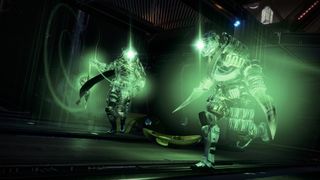
Roaming supers are going to get a buff…
Supers in Destiny generally fall into two camps: Massive burst damage or running around hitting stuff. There are notable exceptions, like Well of Radiance and Ward of Dawn, both of which offer utility in the form of damage buffs and healing, but generally players gravitate to whatever does the most damage the quickest. Having seen some disappointment that the Titan's Strand super is a 'roaming' variant, I want to know whether it's becoming harder to find new design space for supers. Both Yanes and Smith think there's plenty of room to explore. "A lot of our supers right now are 'melt dudes in fantastic fashion' and there's total validity to that apex power expression," says Yanes. "But one of the things we tried to do—especially on the Darkness subclasses—is find a different avenue."
The team has plans for roaming supers in PVE to slot them into more compelling roles versus one-off supers.
—Kevin Yanes, design lead
Yanes cites how the Stasis and Strand subclasses lean into using their respective keywords to create new kinds of super. You can see that philosophy at work with the Titan Bladefury super, which has two attacks, both of which use Strand verbs. Smith explains: "The light attack is a melee which you can chain infinitely, and the heavy attack is a projectile that comes out and 'Suspends' enemies on impact. So it is a roaming super, but it allows me to hold enemies in place and then close the gap really quickly." Note that those light attacks increase in speed as you land them and they also 'Sever' enemies, lowering their damage output.
That should help with survivability, which has been a perennial issue with roaming supers in harder content. "Speaking more philosophically," says Yanes, "the team has plans for roaming supers in PVE to slot them into more compelling roles versus one-off supers." They can't go into detail yet, but Smith mentions they're looking at damage output and orb generation as the areas for improvement.
…and it sounds like a nerf is coming for Well of Radiance
It's clear that Bungie doesn't want to just create supers that do more and more damage. "We're trying to brace the community for a place where there are different mechanical outputs for supers," says Yanes. "We're going to start playing with that more as time goes on, so you're going to see less variations of 'it just murders everything', and a lot more variations of 'it has a specific role and it applies to our team comp'." He acknowledges that the danger when designing a utility-based super is threading the needle between making it useful enough, but not so useful that you feel like you have to equip it in every encounter until the end of time, the obvious example being Warlock's Well of Radiance. "That's probably in the realm of too useful," says Yanes, with the kind of twinkle in his eye that suggests it's going to be nerfed sooner rather than later.
[UPDATED: Or maybe not. Kevin Yanes replied to my speculation that a Well nerf was coming, saying this on Twitter: "Don’t read too much into nothing. No plans to do this."]
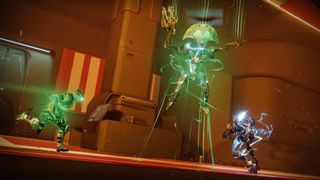
The Warlock Broodweaver super was going to turn you into an actual goddamn spider at one point
Here's a wild one. Normally, asking the question 'what kind of crazy stuff did you cut?' results in terrible answers, because no dev wants to talk about something cool that didn't make it into the game. Except Bungie, apparently. "The Warlock Broodweaver's super was originally going to transform you into a giant spider that launched spider eggs and had spider babies running around instead of threadlings," says Smith. Uh. Okay. Sounds amazing, can we have that please? Apparently not, because trying to transform the warlock's bipedal model into an eight-legged creature required so much work that it ended up being out of scope. "Also, arachnophobia is a real thing," he adds.
You had these three T-posing screebs vomiting threadlings. It was hilarious but also horrifying.
—Kevin Yanes, design lead
Yanes has his own story to share: "One of my favourite prototypes was an early Warlock super where you would spawn these aerial threadlings but they were just screebs that were T-posing and they would slowly go towards [the enemy] and then shoot threadling eggs. So you had these three T-posing screebs vomiting threadlings. It was hilarious but also horrifying." Nightmare fuel aside, the Warlock super shipping with Lightfall still leans into the minion master fantasy. On cast, Needlestorm launches a burst of Strand spikes which detonate on impact and then turn into threadlings that chase anyone left alive before exploding. Smith says that during development it felt like a failure if Needlestorm played too much like a green version of Hunter's Blade Barrage super. "That was actually a negative feedback point we got," he says. "So [we decided] it should be about the armada of little green dudes you're making."
Warlocks get to use threadlings very differently to the other classes
Every Strand class will be able to generate threadlings, but Warlocks have what Smith describes as a "special kinship" with the explosive little critters. In the event that your threadlings don't find a target, they'll return to the Warlock and condense down into a form that orbits you like an Arc Soul or Child of the Old Gods. This behaviour is called 'perching', and you can have various numbers of threadlings perched at any one time. "Next time the Warlock attacks an enemy, they're going to pop off and attack it," says Smith.
Threadlings can be generated in multiple ways, depending on how your character is set up. For instance, using the Weaver’s Call aspect, whenever the Warlock casts a rift they will weave three threadling eggs that hatch when they hit a surface. Additional perched threadlings will also be converted to eggs. If you aren't interested in grappling, there's also a threadling grenade. Yanes, who admits to being a Warlock main but insists that means he avoids overtuning the class, explains how it works: "A totally valid behaviour for Warlocks is: 'I'm going to consume this threadling grenade, create a full perch, and then dump it all and have my children wreak havoc.'" Honestly, I know what I'll be playing on day one.
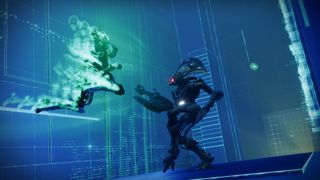
Stasis was once time crystals
Let's end on a fun one. Discussing how much subclasses change during the creative iteration process, Yanes has this to share: "Stasis was originally going to be time crystals. It wasn't going to be cosmic ice. But we didn't want to do the generic fantasy thing of: "It's frost! Brrr!' We always want there to be a Destiny interpretation of the power. Something that is uniquely our game. Solar isn't just 'fire', it's the power of the sun. Void isn't just 'black holes', we're plucking sentient creatures from the cosmos and sending them to convert life for us."
We didn't want to do an explicitly damage-focused thing... We decided that we were going to look at combat utility.
—Kevin Yanes, design lead
But how did the team arrive at magical green ropes binding the cosmos together? "We didn't want to do an explicitly damage-focused thing," says Yanes. "Early on we decided that we were going to look at combat utility. We did a lot of work on damage mitigation… Lowering the damage of enemies. That got us into the headspace of severing enemies' connection to the greater world. We started getting down the idea that everyone's connected by this extradimensional construct that is the weave."
As for the visual look of Strand, Yanes says consistency was key: "We keyed off of the Darkness resonance. Even on Stasis, we wanted to make sure that everything had a consistent physical language to the Darkness resonance… We didn't want it to look ethereal and magical in the way that the Light subclasses do." Put another way, the Darkness subclasses are about physicality, and if Stasis has crystals then Strand has strings. "That started to inform the rest of the powerbase," says Yanes. "What can we do with strings that we couldn't do before? Oh, we're going to have rope weapons. We began talking about grappling hooks. The visuals started becoming clear. It's all discovery. We started from the first point of dark telekinesis, and we had a bunch of other goals that then led us down another path…
In my experience, you can have the plan laid out, but you need to afford yourself that room for discovery. I promise you the plan in your head will not work out the way you think it does."
Some answers have been edited for length and clarity. Destiny 2: Lightfall launches on February 28.
With over two decades covering videogames, Tim has been there from the beginning. In his case, that meant playing Elite in 'co-op' on a BBC Micro (one player uses the movement keys, the other shoots) until his parents finally caved and bought an Amstrad CPC 6128. These days, when not steering the good ship PC Gamer, Tim spends his time complaining that all Priest mains in Hearthstone are degenerates and raiding in Destiny 2. He's almost certainly doing one of these right now.
Most Popular

